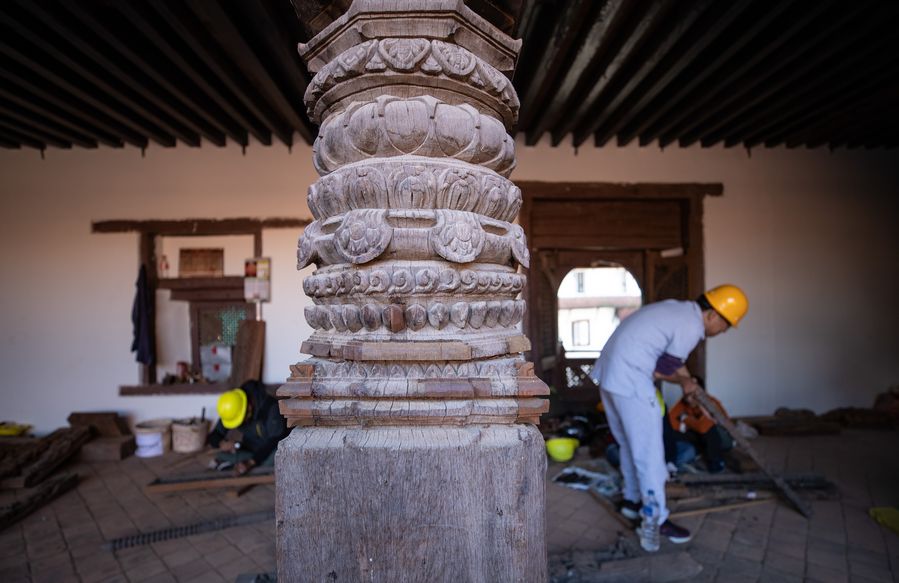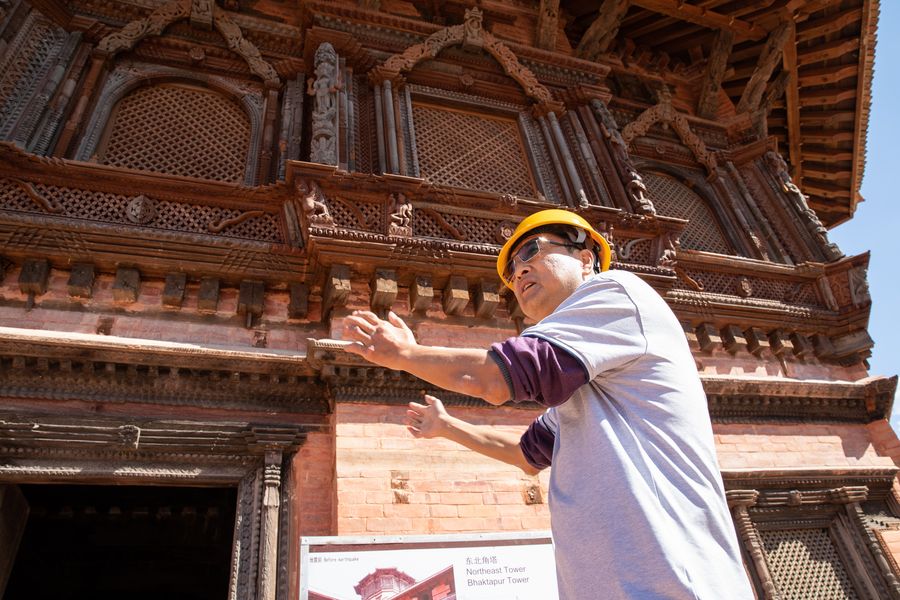Chinese restoration specialists help Nepal recover soul of Kathmandu Valley culture
"Restoring the temple is a journey of learning from each other," said Guo Qianru, a CACH member working on the Basantapur complex project. "We shared our experiences and management with the Nepali side, and they also taught us about Nepali culture, religion and their traditional crafts. It is an exchange between different civilizations."

Zhou Jianguo (L) instructs Nepali workers at the restoration site of the nine-storeyed Basantapur complex in Kathmandu, Nepal, on Oct. 10, 2019. [Photo/Xinhua]
Learning from each other
The Basantapur complex amazes people with its exquisite and sophisticated wooden sculptures. "To restore or make a copy of them is the most challenging task, as the ways Nepali ancestors followed are totally different from the Chinese (ways)," Zhou said.
"Upon carving, Chinese people will first make a design to follow, but for Nepalese, they can directly carve the Buddha, gods and other animals and monsters in different shapes according to their religion. All the designs have been carved in their minds," Zhou said.
To find qualified artistic carpenters, the Chinese team visited many Nepali villages to invite skilled workers to join the restoration team.
Sanu Kaji Shakya from the village of Bungmati has worked in the restoration project for the last 18 months. "I feel proud that I could help in the reconstruction of this nine-storey building. I have an experience of 20 years in carving. I learned it from the older generations: fathers and brothers and seniors."

People work at the restoration site of the nine-storeyed Basantapur complex in Kathmandu, Nepal, on Oct. 10, 2019. [Photo/Xinhua]
Shakya and his fellows are tasked with fixing the damaged sculptures and statues with original materials, and making new ones to replace the lost ones. A small wooden pillar needs two days to complete, while a piece of a delicate god statue may take them one week or longer.
As a joint venture, the Chinese and Nepali sides sometimes have different ideas and principles. The Chinese team insists on the principle of "minimum intervention," but the Nepali side wants brand-new replacements.
"From the beginning, our Nepali counterparts didn't agree with our thoughts of repairing the old," said Zhou, adding that the Nepali side gradually accepted the Chinese principles of restoring heritage pieces by "rebuilding the soul of the relics."
"Restoring the temple is a journey of learning from each other," said Guo Qianru, a CACH member working on the Basantapur complex project. "We shared our experiences and management with the Nepali side, and they also taught us about Nepali culture, religion and their traditional crafts. It is an exchange between different civilizations."

Zhou Jianguo works at the restoration site of the nine-storeyed Basantapur complex in Kathmandu, Nepal, on Oct. 10, 2019. [Photo/Xinhua]
Enhancing cultural inheritance
Zhou said the restoration project will contribute to maintaining Nepal's history and culture. "We are trying to restore the heritage and make it stronger than before, so that it can survive longer."
"We met difficulties during the work due to lack of detailed references about the heritage, but we have drawn pictures and made specific records for our restoration regarding the methods and crafts. We will provide the record to the Nepali side in case they need to maintain the heritage," Zhou said.
The Chinese team is also planning to establish a digital museum about the sculptures in the temple, said Guo.
It is worth making a digital collection because "sculptures of the nine-storeyed Basantapur complex are among the best," Guo said.
"For years, there were no chances for the craftsmen to exercise their skills, and the traditional market is shrinking as many of the craftsmen now work as tour guides or vendors in the tourism sites," Guo said.
"But with the project, many craftsmen have taken up their former occupations to save their culture. It is also a cultural inheritance for the locals, as the more they practice, the more skills can be taught to the next generations," Guo said.
The hilly country of Nepal is known for its exotic and mysterious Himalayan culture and ancient heritages of Buddhism and Hinduism, attracting numerous visitors from the rest of the world to the nation for "soul purifying" journeys.
The Chinese restorers have said they hope to help revive the allure of Nepal.

